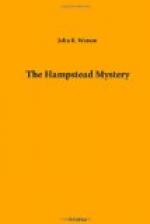“It’s scarcely necessary,” said Mr. Holymead, who saw the trap, and replied in a tone which indicated that the matter was not worth a moment’s consideration.
He began his address to the jury by emphasising the fact that a fellow creature’s life depended on the result of their deliberations. The duty that rested upon them of saying whether the prosecution had established beyond all reasonable doubt that the prisoner shot Sir Horace Fewbanks was a solemn and impressive one. He asked them to consider the case carefully in all its bearings. He could not claim for his client that he was a man of spotless reputation. The prisoner belonged to a class who earned their living by warring against society. But that fact did not make him a murderer. On what did the case for the prosecution rest? On the evidence of Hill and three other witnesses who, on the night of the murder, had seen a man somewhat resembling the prisoner in the vicinity of Riversbrook, or making towards the vicinity of that house. But so far from wishing to emphasise the weakness of identification he admitted that the prisoner went to Riversbrook with the intention of committing a burglary.
“We admit that he went there the night Sir Horace Fewbanks returned from Scotland,” he continued. “Counsel for the prosecution will make the most of those admissions in the course of his address to you, but the point to which I wish to direct your attention is that we make this damaging admission so that you may decide between the prisoner and the man who led him into a trap by instigating the burglary. Now we come to the evidence of Hill. I know you will not convict a man of murder on the unsupported evidence of a fellow criminal. But I want to point out to you that even if Hill’s evidence were true in every detail, even if Hill had not swerved one iota from the truth, there is nothing in his evidence to lead to the positive conclusion that the prisoner murdered Hill’s master, Sir Horace Fewbanks. What does Hill’s evidence against the prisoner amount to? Let us accept it for the moment as absolutely true. Later on I will show you plainly that the man is a liar, that he is a cunning scoundrel, and that his evidence is utterly unreliable. But accepting for the moment his evidence as true the case against the prisoner amounts to this: by threats of exposure Birchill compelled Hill to consent to Riversbrook being robbed while the owner was in Scotland.
“Hill’s complicity, according to his own story, extended only to supplying a plan of the house and giving Birchill some information as to where various articles of value would be found. On the 18th of August Hill went to Riversbrook to see that everything was in order for the burglary that night. While he was there his master returned unexpectedly. Hill then went to the flat in Westminster and told Birchill that Sir Horace had returned. His own story is that he tried to get Birchill to abandon the idea of the burglary, but that Birchill, who had been drinking, swore that he would carry out the plan, and that if he came across Sir Horace he would shoot him. What grudge had Birchill against Sir Horace Fewbanks? The fact that Sir Horace had discarded the woman Fanning because of her association with Birchill. Gentlemen, does a man commit a murder for a thing of that kind?




